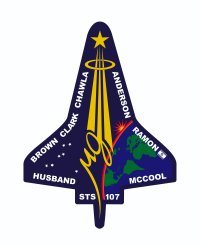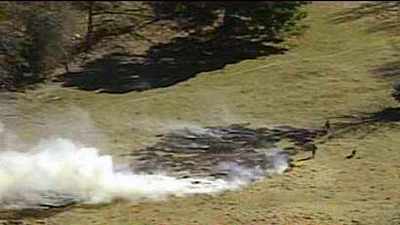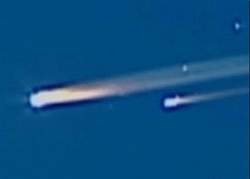Shuttle Showed Sensor Failures Moving Inboard From Wing
Timeline To Disaster
All Times: Central Standard Time
 NASA's version of minute-by-minute events during
the last moments of the Space Shuttle Columbia:
NASA's version of minute-by-minute events during
the last moments of the Space Shuttle Columbia:
0753: (Over California) Four heat
sensors monitoring the flight controls on the left wing fail.
Sensor junction box located in left wheel well. Temperature
monitors on strut actuator, elsewhere in wheel well show heat
increasing 25-30F in a span of five minutes.
0754: (Over Eastern California, Western
Nevada) Left bondline temperature sensor shows significant
temperature rise -- 60F in five minutes. Right bondline temperature
gauge shows only minor increase in temperature of 15 degrees. No
temperature increase noted in payload bay on either side.
0758: (Over New Mexico) Flight Control
System (FCS) compensates for left roll, indicating an increase in
drag on the left wing. Left gear and hydraulic line temperature
sensors fail. Pressure sensor monitoring tires in left main gear
fail.
0759: (Over West Texas) FCS again
adjusts roll trim, indicating increasing drag on the left side of
the spacecraft. Final voice transmission between Mission Control
and Challenger is interrupted by loss of signal.
Sunday's NASA Briefing
"We're beginning to make progress" Shuttle Program Manager Ron
Dittemore told reporters Sunday, as the investigation into why the
Columbia came apart during re-entry began to focus on the space
plane's left wheel well. That's approximately where a piece of
insulating foam from the external tank smacked the orbiter, turning
into a cloud of dust during lift-off on January 16th.

"It's very interesting," said Dittemore, "(Saturday), we told
you that we lost instrumentation readings on the trailing edge of
the left wing. The wires for those sensors junction in the wheel
well."
"It's looking more and more like a thermal event," said
Dittemore, "more than a structural event. But I caution you, it's
still early in the investigation."
A NASA-led investigation board arrived at Barksdale AFB,
Shreveport (LA) to take over local and federal search efforts. Law
enforcement officials in East Texas reported thousands of debris
sites strewn across an area five thousand square miles wide.
Dittemore said Sunday NASA engineers were trying to retrieve as
much as 32 seconds of data recorded after the shuttle breakup from
computers at Mission Control in Houston. That information, he said,
could yeild vital clues into the cause of the shuttle disaster.
NASA investigators had also spoken with astronomer Anthony
Beasley an Australian working at an observatory north of Los
Angeles. Beasely told ABC's Peter Jennings on Saturday that he saw
pieces of what appeared to be thermal tile break off and trail the
orbitor as it streaked toward its landing at the Kennedy Space
Center in Florida.

"After the first few flashes I thought to myself that I knew the
shuttle lost tiles as it re-entered and quite possibly that was
what was going on," Beasley said on ABC. "I think that after the
particularly bright event I started to wonder whether or not things
were happening how they should."
Dittemore said Beasley's statement was being reviewed at the
Johnson Space Center and significant times were being correlated to
see if a loss of tiles might have indeed caused the shuttle to
disintegrate.
"Yesterday was... the hardest day of my life."
Flight Crew Operations Director Bob Cabana was still obviously
choked up at the news conference, one day after he had to gather
the crew's families together and break to them the tragic news.
"yesterdfay was probably the hardest day of my life," Cabana said.
"To have to sit down with the families of close friends and tell
their wives, children and parents their loved one isn't coming
home.... I don't know if you ever had to do that. I hope you never
do."
Cabana said astronauts have been assigned to each of the seven
Columbia crewmembers' families as "Casualty Assistance Officers,"
seeing after the families' needs in every possible way.
NASA officials wouldn't detail reports that human remains had
been found among the bits of shuttle debris. Cabana did confirm
that remains had been found. "We're honoring our fellow crewmates,"
he said. "We're taking good care of them."
 Classic Aero-TV: Active Winglets -- Tamarack Aerospace Partners with Cessna
Classic Aero-TV: Active Winglets -- Tamarack Aerospace Partners with Cessna Aero-News: Quote of the Day (05.03.25)
Aero-News: Quote of the Day (05.03.25) ANN's Daily Aero-Term (05.03.25): Taxi
ANN's Daily Aero-Term (05.03.25): Taxi ANN's Daily Aero-Linx (05.03.25)
ANN's Daily Aero-Linx (05.03.25) Airborne 05.02.25: Joby Crewed Milestone, Diamond Club, Canadian Pilot Insurance
Airborne 05.02.25: Joby Crewed Milestone, Diamond Club, Canadian Pilot Insurance





